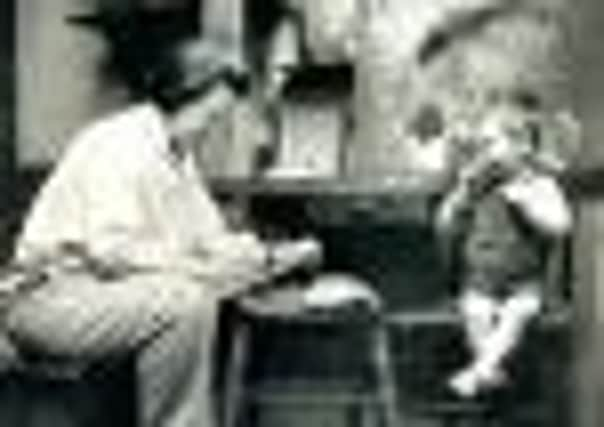Art review: Joan Eardley exhibition and book


Her words, penned in a tribute marking the death of the artist at the age of 42 in 1963, have been embargoed for almost five decades. But a new book about Eardley by Christopher Andreae, to be published next month, and a forthcoming exhibition at the Scottish Gallery in Edinburgh have finally brought this tender love affair into the light.
Walker’s photographs of Eardley have long been known of and are held in the archive of the Scottish National Gallery of Modern Art. They show Eardley in her chaotic studio in Glasgow’s Townhead in the 1950s, drawing and painting the local children who gathered there. The nearby streets were boarded up, the walls graffiti-scrawled. But Eardley’s children were painted with dignity and quiet intensity, every one an individual.
Advertisement
Hide AdThen there’s the pastoral Eardley painting contentedly in fields. Or the fierce, indomitable Eardley battling wind and weather in the Aberdeenshire village of Catterline, where she made her finest paintings: the landscapes and wild seascapes that revealed her absolute compulsion to paint.


Should the love affair between the painter and Walker, ten years her senior, a mother and the wife of a Glasgow sheriff, make a difference to our feelings about any of this? The life is not the work.
At least I thought so until reading Andreae’s book. Eardley’s painting life was terribly hard, working through extreme weather and latterly through terrible ill health. Walker’s support nurtured her both emotionally and practically. “She so longed for a right wee home,” wrote Walker, “and was so happy when there was a wee person there, I really think she did, as she said she did, do some of her best work.”
For Adele Patrick, an expert in women’s history and a founder of Glasgow Women’s Library, the life and the work cannot be separated. “Art and life cannot be hermetically sealed. We hear so much about male artists and their muses, it’s important to recognise these kind of loving and nurturing relationships between women.”
Both women were sustained by creativity. “Music and painting are such important things,” Eardley wrote to Walker. “And the fact that we both try to make a little something of them seems a sort of added bond.”
The pair met in 1952. From 1954 Eardley wrote to Walker almost daily and the letters, which reveal the artist’s life and routines, are tender and intimate. Both Walker and Eardley believed that the artist worked better when they were able to spend time together in Catterline. When Walker regretted not being able to attend Eardley’s solo London show at Roland, Browse and Delbanco, the artist responded: “Why worry, you’re there anyway in my paintings.”
Advertisement
Hide AdEardley’s life was cut tragically short by cancer at the age of just 42. She was born in Sussex, studied briefly in London, but largely at Glasgow School of Art and later at Patrick Allan Fraser’s Hospitalfield House in Arbroath. Her peripatetic lifestyle had begun with the failure of the family dairy farm when she was an infant. Eardley’s father had never recovered from being gassed in the First World War. He had a nervous breakdown and took his own life.
The family had Scottish roots and moved to Bearsden, and at Glasgow School of Art, Eardley’s star rose. In Townhead and Catterline she found her voice, one now recognised as uniquely expressive and impressively dedicated. Walker’s previously unpublished tribute is an extraordinary testament of her love for the painter: “Her courage and triumph over the appalling conditions in which she painted these wonderful seas, when so often she was suffering physical pain, is something to make an ordinary creature very humble.”
Advertisement
Hide AdSoft-spoken and gentle in public, Eardley had a ferocious and driven aspect which Walker admired. This side, she felt should be recorded and one day published, to reveal “Joan, the person as well as Joan the painter.”
Walker wrote for posterity and she wrote poetically: “I always identify Joan with the sea… there is the gentle sunlit sea one delights in, in the summer… this was the Joan that I think everyone knew. But there is the magnificent winter sea in all its grandeur and wild turbulence. This was Joan too.”
For Patrick, the fact that Eardley’s lover was a married woman is not surprising. Such circumstances were, “absolutely routine since the 19th century”. The library’s own important archive of lesbian history, she says, is testament to loving and enduring relationships between women where one was in a marriage. It’s complex for surviving families, she acknowledges, “but these are significant stories”.
The library has long been interested in Eardley as a pioneering artist and complex historical figure. Patrick, who, like Eardley, studied at Glasgow School of Art, cites Eardley’s extraordinary 1955 portrait of Angus Neil, her friend and fellow painter whose adult life was blighted by mental health problems.
Eardley’s portrait of him, vulnerable and naked, became a newspaper scandal as it was considered an unsuitable work for a “girl painter”. It was a warning shot about what the media and the art world would tolerate. Says Patrick: “It’s important to know, especially with women, about the things that have inhibited the work and the things that have fostered it.”
For Adele Patrick the most important thing in recording women’s lives is “seeing the life through the person’s own interpretation, their own testimony and that of those who are close to them”. It is this testimony that Audrey Walker’s papers bring to light for the first time. And what loving testimony it is. “To me she was quite simply like the winter sea,” wrote Walker. “To which and for which I would give my life.”
Twitter: @moirajeffrey
• Joan Eardley by Christopher Andreae is published by Lund Humphries in April. Joan Eardley is at the Scottish Gallery from Wednesday to 27 April